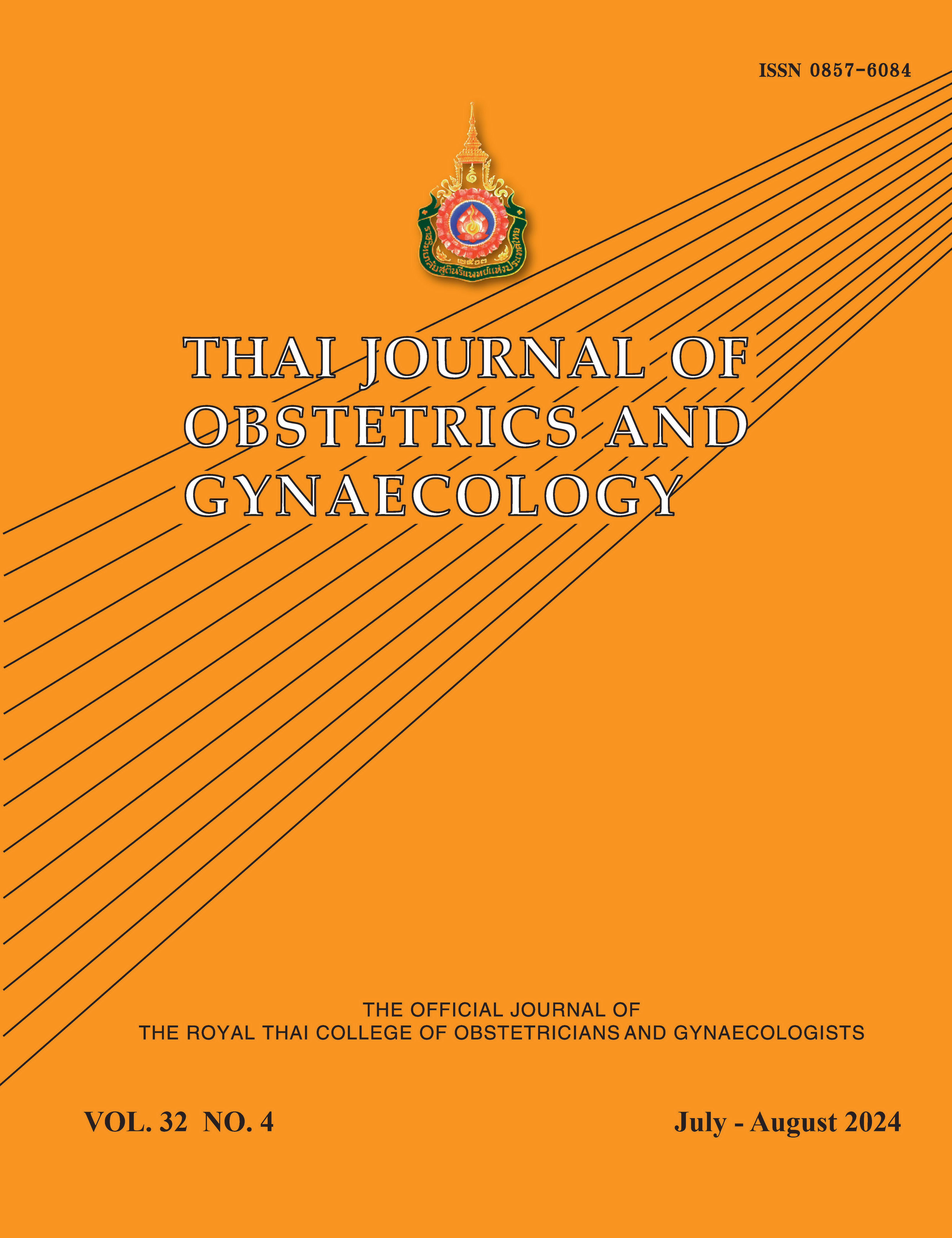Validity and Reliability of Thai Version of the Overactive Bladder Questionnaire Short form (OAB-q SF) in Women with Overactive Bladder
Main Article Content
Abstract
Objectives: To study the validity and reliability of Thai version of the OAB-q SF and the correlation of Thai version OAB-q SF to Thai version OAB-q.
Materials and Methods: During December 2017 to February 2018, after IRB approvement, 46 Thai patients diagnosed as having OAB attending a Female Pelvic Medicine and Reconstructive Surgery clinic at King Chulalongkorn Memorial hospital were recruited. Patients’ characteristics were recorded. The self- answered, Thai version of the OAB-q SF was administered on two occasions, at the day of recruitment and at 2 weeks apart (by mail). Thai version of OAB-q was administered only at the first visit.
Results: Mean ± standard deviation of age was 65.63 ± 11.64 years, and their mean body mass index (BMI=-0987 was 26.25 ± 8.13 kg/m2. Most women were treated for OAB more than 6 months (47.9%). Behavioral modification was used to treat in all patients. Oral medication was administered in 54.35% of patients. Cronbach’s alpha of the OAB-q SF was 0.80 and 0.93 for symptom-bother and HRQL domains, respectively. The ICCr of symptom bother scale and HRQL were 0.90 and 0.94. The content validity index was equal to 1. Pearson correlation of the total score of the OAB-q SF and OAB-q was 0.95 for the first visit questionnaire.
Conclusion: Thai version of the OAB-q SF showed good psychometric properties (reliability and validity) for measuring the OAB symptom severity and HRQL. There was very strong correlation between Thai version of OAB-q SF and OAB-q.
Article Details

This work is licensed under a Creative Commons Attribution-NonCommercial-NoDerivatives 4.0 International License.
References
Garnett S, Swithinbank L, Ellis-Jones J, Abrams P. The long-term natural history of overactive bladder symptoms due to idiopathic detrusor overactivity in women. BJU Int 2009;104:948–53.
Coyne KS, Sexton CC, Kopp ZS, Ebel-Bitoun C, Milsom I, Chapple C. The impact of overactive bladder o mental health, work productivity and health-related quality of life in the UK and Sweden: Results from EpiLUTS. BJU Int 2011;108:1459-71.
Coyne KS, Sexton CC, Thompson C, Kopp ZS, Milsom I, Kaplan SA. The impact of OAB on sexual health in men and women: Results from EpiLUT. J Sex Med 2011:8:1603-15.
Abrams P, Artibani W, Cardozo L, Dmochowski R, van Kerrebroeck P, Sand P. Reviewing the ICS 2002 terminology report: the ongoing debate. Neurourol Urodyn 2009;28: 287.
Coyne KS, Sexton CC, Bell JA, Thompson CL, Dmochowski R, Bavendam T, Chen CI, Quentin Clemens J. The prevalence of lower urinary tract symptoms (LUTS) and overactive bladder (OAB) by racial/ethnic group and age: results from OAB-POLL. Neurourol Urodyn 2013;32:230-7.
Lapitan MC, Chye PLH. Asian-Pacific Continence Advisory Board. The epidemiology of overactive bladder among females in Asia: a questionnaire survey. Int Urogynaecol J 2011;12:226-31.
FDA. Guidance for Industry: Patient-reported outcome measures – Use in medical product development to support labeling claims. In: Office of the Federal Register, National Archives and Records Administration. Federal Register. Washington, DC: Food and Drug Administration 2009:65132-3.
Revicki D, Hays RD, Cella D, Sloan J. Recommended methods for determining responsiveness and minimally important differences for patient-reported outcomes. J Clin Epidemiol 2008;61:102-9.
Coyne K, Revicki D, Hunt T, Corey R, Stewart W, Bentkover J, Kurth H, Abrams P. Psychometric validation of an overactive bladder symptom and health-related quality of life questionnaire: The OAB-q. Qual Life Res 2002;11:563-74.
Coyne KS, Matza LS, Thompson C, Jumadilova Z, Bavendam T. The responsiveness of the OAB-q among OAB patient subgroups. Neurourol Urodyn 2007;26: 196-203.
Matza LS, Thompson CL, Krasnow J, Brewster-Jordan J, Zyczynski T, Coyne KS. Test-retest reliability of four questionnaires for patients with overactive bladder: The overactive bladder questionnaire (OAB-q), patient perception of bladder condition (PPBC), urgency questionnaire (UQ), and the primary OAB symptom questionnaire (POSQ). Neurourol Urodyn 2005;24: 215-25.
Bunyavejchevin S, Liao L, Lu SH, Choo MS, Rabbani KJ, Havanond P. Should we use the shorter Thai-version quality of life and symptoms questionnaires in women with overactive bladder. J Obstet Gynecol Res 2015;41:1260-65.
Coyne KS, Thompson CL, Lai JS, Sexton CC. An overactive bladder symptom and health-related quality of life short-form: Validation of the OAB-q SF. Neurourol Urodyn 2015;33:255-63.
Zou GY. Sample size formulas for estimating intraclass correlation coefficients with precision and assurance. Stat Med 2012;31:3972-81.
Tavakol M, Dennick R. Making sense of Cronbach’s alpha. Int J Med Educ 2011;27:53-55.
Koo TK, Li MY. A guideline of selecting and reporting intraclass correlation coefficients for reliability research. J Chiropr Med 2016;15:155-63
Schober P, Boer C, Schwarte LA. Correlation Coefficients: Appropriate Use and Interpretation. Anesth Analg 2018;126:1763-8.
Arlandis S, Ruiz MA, Errando C, Villacampa F, Arumí D, Lizarraga I, et al. Quality of life in patients with overactive bladder: Validation and psychometric properties of the Spanish overactive bladder questionnaire-short form. Clin Drug Investig 2012; 32: 523-32.
Wild D, Grove A, Martin M, Eremenco S, McElroy S, Verjee-Lorenz A, Erikson P; ISPOR task force for translation and cultural adaptation. Principles of good practice for the translation and cultural adaptation process for patient-reported outcomes (PRO) measures: report of the ISPOR task force for translation and cultural adaptation. Value Health 2005;8:94-104.


